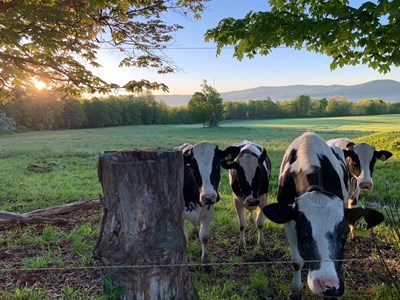
Few business areas have been hit as hard by the coronavirus as farming, especially dairy farming. The International Dairy Foods Association predicts the dairy industry will lose $5-10 billion in the remainder of the year. Vermont must allocate ample funding for its dairy farmers out of its $1.25 billion grant from the federal Coronavirus Relief Fund.
In few states are dairy farms as symbolic of traditional culture as in Vermont. Farms and landscape are about more than just milk production -- they are about tourism, support for rural communities, a draw for residency, a way of life.
New Hampshire also received $1.25 billion in federal grant money, and is expected to promptly divert $5 million to that state’s dairy farms. New Hampshire has only about 90 dairy farms, whereas Vermont reportedly has 677. Will Vermont ensure that its dairy farms similarly receive relief from the dramatic financial harm they are enduring? After all, the relief funds are supposed to be applied toward losses incurred due to coronavirus, and that is clearly so for dairy farms.
New Hampshire’s proposed subsidy will average $55,556 per farm; a comparable distribution in Vermont would approximate $37.6 million. New Hampshire attributes about $191 million in annual sales to its dairy industry, or roughly 30% of its agricultural production. In Vermont, annual dairy product sales are estimated at $1.2 billion, or 65% of total agricultural receipts.
The contrast in these two states is even greater when the impact of dairy farming on tourism is considered. New Hampshire is not exactly known for its cows. But Vermont is more dependent on them than it realizes:
10 million people visited the Green Mountain State in 2009, many of whom were attracted by the beauty of the landscape. These visitors spent over $1.42 billion, generated about $200 million in tax and fee revenues, and contributed to the employment of 33,530 people.
Vermont is far more dependent than New Hampshire on its dairy farmers for the health of its economy and communities.
Vermont’s Senate Agriculture Committee last week considered payments to Vermont farms of a maximum of $50,000 (for a large farm), and lesser amounts in gradation for smaller operations. This is substantially less than in New Hampshire.
Governor Scott must ensure that federal monies are not diverted for pet projects like renewable energy programs that were not harmed by covid. These funds must be invested to bolster our core industries, especially those hit hardest.
Additional grants will be provided to Vermont through the CARES Act. In his proposals for the application of these other CARES Act grant moneys, Senator Patrick Leahy allocates $4.3 million for child care, $4.6 million for housing assistance, $4.1 million for low income heating assistance, $9.6 million for airports, $20 million to “support public transportation emergency relief,” and $175,000 for small- and medium-sized manufacturers. There is no consideration of farms and agriculture.
Vermont needs to equip its economy to grow, and yield tax revenues. Home heating oil, housing assistance, public transportation -- these are services that produce nothing for economic growth. Dairy farming is the core of Vermont’s agriculture. Agriculture is the foundation of Vermont’s tourism industry, and of its very character. Growth in the economy yields the tax revenues to subsidize fuel, housing and food -- not the other way around.
How can Vermont’s dairy farmers hope for financial relief when their U.S. Senator ignores them in favor of airports and public transportation? Governor Phil Scott must insist that Vermont’s dairies are properly supported through the greatest crisis they have ever faced. Substantial support for Vermont farms must be ensured through fair dispensation of Coronavirus Relief Funds.